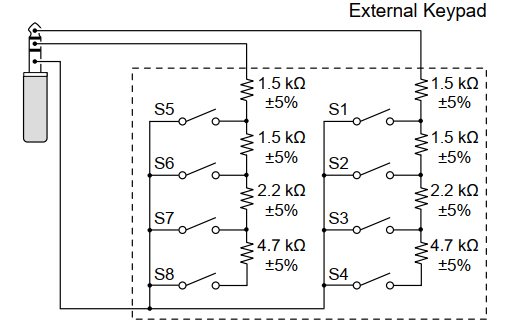Two-in-One !
The IC-705 manual shows a simple circuit to add some message buttons to the paddle/key input (see page 13-2 in the Basic Manual).
 (source: Icom)
(source: Icom)
Keying the rig for CW is done by grounding the TIP (Dot) or RING (Dash) of the connector, but when you connect a certain resistance to ground, one of the 8 stored messages is transmitted.
This works for CW, Voice and RTTY, if you don’t forget to change the appropriate settings via MENU > Set > Connectors > External Keypad.
Such a box with buttons is available commercially, like this one at Wimo
Cheaper versions can be found on Amazon, Ali Express, etc.
On that box, two buttons are provided to key some CW, but I doubt you will make very long QSO’s with those buttons. It's probably OK for an emergency, like keying with the microphone buttons.
But for real CW ragchewing, you still need to connect an external key or paddle.
So that got me inspired to brew my own … and include the paddle IN the box.
And it cost me virtually nothing !
The box I used was from a small laptop adapter. The large hole where the mains socket was, is now the opening for the paddle.
I didn’t really need all 8 messages for regular SOTA or POTA operation, so I made a box with only four buttons, connected to the TIP, and a 3.5mm connector. The box is connected to the IC-705 with a regular 3.5 mm stereo cable.
If I ever wish to use the other 4 messages, I could easily add a small slide switch to move the resistor chain to the RING, for message 5 - 8.
And if I want to use an external key or paddle, I can still add another 3.5 mm connector, in parallel to the first one.
The paddle was inspired by the work of Carel, PA0CMU, see his PCB paddles here
So I took some pieces of single sided copper clad board, and started cutting and filing :
- a bottom plate for the box (8 cm x 4.5 cm), glued inside the box
- two paddles, with copper removed where it is not needed (9 cm x 2cm), soldered to the bottom plate at the back end
- A HEX standoff with a washer is soldered to the bottom plate as the center contact
This is what I got before assembling :
To make sure the paddles wouldn’t collapse or come loose with “heavy copper pounding”, I added a small piece of PCB between the two paddle arms. A 3.5 mm stereo connector is mounted on the side of the box. This is the finished paddle (bottom part).
The top cover contains the four buttons and four resistors, wired as in the diagram from the manual.
As you can see, I drilled the holes for 8 buttons, but then decided to mount only 4 ...
See the picture at the top for the final result, including a label showing what's stored in the messages.
There is no provision to adjust the spacing (yet), but a larger size washer would fix that. I chose a rather wide spacing, since I may use the paddles with gloves on, during a winter SOTA or POTA activation.
The tension is also fixed, but I think I got it just right by filing away enough of the PCB material in the middle of the paddles. A spring or two small magnets may be an option if you wish, but I didn’t want to make it too complicated.
And it works !
I did a POTA activation recently, and made 16 CW QSO's in just 26 minutes, the only errors were 'operator' errors, not the fault of the paddle, hi.
73 de Luc, ON7DQ



No comments:
Post a Comment
All reactions will be moderated. Publicity or links to other sites are not allowed.